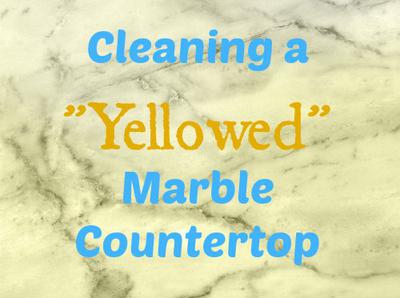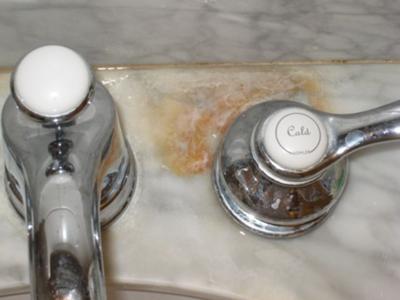Marble Vanity Yellowing
QUESTION:
How do I get yellowing out of an ivory marble countertop?ANSWER:
The solution for cleaning yellowed marble countertops depends on what is causing the yellowing.3 Possible Causes of Yellowing Marble Countertops:
- Wax or coating applied to surface
- Poor cleaning method
- Iron deposits oxidizing
Waxes & Coatings
Generalized yellowing over an entire countertop or marble vanity top is usually due to the application of a wax or other topical coating.
Waxes and such used to be commonly applied to marble to enhance the shine and provide a bit of surface protection. But, in reality, they end up being much more of a maintenance hassle and don't really offer much protection.
These days waxes and permanent topical coatings are not recommended because they scuff easy, get dull quickly, need constant maintenance (stripping and re-application)... and eventually turn yellow.
Old wax needs to be stripped off and the marble cleaned. We recommend using this stone-specific Wax Stripper / De-Greaser that is safe for marble cleaning.
If a wax or coating was on the marble for a long period of time, or repeatedly applied, it can actually turn the marble itself yellow.
In this case, also try to clean with the "Wax Stripper", however, the surface may need to be professionally re-finished to remove the discolored layer of the marble.
Poor Cleaning Methods
Infrequent cleaning, insufficient and/or poor cleaning methods (using dirty mops, sponges) can result in dust, dirt and grime being embedded into the marble countertop surface. Over time the marble becomes a dingy-yellow color.
This is much more common on floors than countertops.
In this case, I'd recommend using an INTENSIVE Tile & Grout Cleaner to clean off ground in grime.
If severe enough though, professional restoration may be required.
Iron Deposit Oxidation
This cause is completely different than the above and more problematic.
Yellow-brown stains can occur when iron deposits in some white marbles are exposed to a large volume or consistent source of water.
Yellowing from iron oxidation (click for details) is far more prevalent on floors and in showers. Very uncommon on a countertop unless the iron is right on the surface. In which case, you can plainly recognize it as the cause of a rust stain.
Rust spots are difficult to remove, but you'll find complete step-by-step instructions in the Removing Granite & Marble Stains ebook (link above).
Return to Cleaning Marble Questions & Answers.
Old Marble Countertop Dull and Yellow
by Chelle
(Savannah, TN)
QUESTION:
I have marble countertops in my bathrooms that are almost 25 years old.They are dull and turning yellow.
Is there any way to clean them and restore them to their natural color and shine?
ANSWER:
Yes, even old, dull and yellowed marble countertops can be cleaned and restored.That's the great thing about natural stone... it can almost always be re-finished to like-new condition.
However, as a point of clarification the marble countertops may have never been "shiny".
Many types of surface finishes and textures can be created on a marble countertop. A shiny "polished" finish is just one type. However, it is very common (especially on older tops) to have a "honed" finish, which is smooth, but not shiny.
I mention this so you have accurate expectations. The "dullness" may not be any type of problem or damage. Whoever installed it may have wanted a more dull or matte finish.
So, after complete marble cleaning you may find a honed finish, which many people mistake as dull, damaged or needing a polish.
You can have your marble countertop re-finished to a polished, or honed, or any other type of finish possible though.
The yellowing is most likely due to a wax that was applied at some time.
Waxing marble used to be very common, but it just creates more maintenance and eventually turns yellow. If repeatedly applied it can turn the actual marble yellow as well.
Waxing is not recommended any more. Much better methods and products exist now.
First, you'll want to strip off whatever is on the surface. This De-Greaser / Wax Stripper is excellent and safe for use on marble (and all natural stone).
After stripping the surface coating you may find stains or etch marks (dull spots).
You can learn all about marble cleaning for these issues (and a lot more) for this extensive marble restoration project in the Cleaning Marble Secrets ebook, which provides the most complete and comprehensive instructions and resources.
Or click here to start learning about various other marble restoration issues you may encounter.
And if after cleaning the marble completely you find the surface is honed or too dull for your liking, then you can have it professionally re-finished to a "polished" finish.
Return to Cleaning Marble Questions & Answers.
Brown Stain on White Marble Bath Vanity
by Chris
(Alexandria, VA)
QUESTION:
Hi, I have a Strasser Woodenworks bathroom vanity, with a white cambria waverton marble top.A brown stain has developed next to the right cold water knob.
What kind of stain is it? And how do I remove it? What products do you recommend? Any help would be appreciated.
ANSWER:
First we need to clarify if you have the Cambria Waverton or Carrara Marble. You say you have the Cambria, but it looks like marble to me (not like the Cambria product)... 99% certain.Cambria is a man-made quartz countertop product. They have a color called "waverton" that does look similar to Carrara marble, but definitely different.
Your faucet seems to be leaking. Could be some faucet putty stain mixed in, but looks mostly like a rust stain.
The water could be rusting part of the faucet or it could be oxidizing metals within the stone.
If it is indeed a Cambria countertop, then call Cambria and ask how to remove a rust stain.
Since man-made quartz is not as forgiving as marble, once stained, you probably can't remove it (again if I'm mistaken and this is a Cambria surface).
The methods to fix stone and remove such a stain can damage the resins, etc. of man-made surfaces. That is one of the advantages of stone over man-made quartz countertops... you can almost always fix or re-finish stone, but not man-made marble quartz or surfaces.
However, I'm betting it's marble and marble stains can be removed using the procedure detailed in the Removing Granite & Marble Stains ebook.
There isn't a product that you can just spray on and scrub this away. Stains get into the pores of the stone below the surface, so typical cleaning methods won't work.
Follow the steps in the ebook for rust stain removal. Rust stains are the toughest to remove, so you'll have to repeat the process several times.
Return to Cleaning Marble Questions & Answers.
Carrera Marble Countertops Brown Stains
by tom
(los angeles, ca)
QUESTION:
My recently installed carrera marble countertops have several light brownish-gray "stains" about 5-6 inches in diameter. Are these normal in carrera marble?ANSWER:
Well, it's certainly possible for marble countertops to be stained. It's not as easy as the internet would lead people to believe, but definitely occurs.Of course, something must stain them. So, no it's not "normal" for stains to just develop. You need to ask yourself what the marble countertop has been exposed to that could have stained it.
Whatever has stained the marble countertop, traditional cleaning methods will not remove the stains.
Follow the detailed steps in the Removing Granite & Marble Stains ebook (links above).
A likely cause is the adhesive (or additives to the glue) used to install the marble countertops.
Certain adhesive mixtures are more prone to quickly leaching through a newly-installed stone slab to the surface causing a stain. Not good.
This type of stain is often greenish, but can simply create a dark spot, which would look grayish on Carrara marble.
Sometimes these glue stains will disappear as the glue evaporates and none returns to the surface.
You may have luck removing or diminishing the stains following the ebook directions. However, since the adhesive is coming from the underside, the stain is full thickness and could just continue to rise to the surface and re-stain.
Sometimes they are permanent.
If this seems to be the case, certainly take it up with your fabricator/installer. Allow a couple weeks for the stains to potentially fade away. Take photos every day to monitor for changes.
If the stains expand or fail to fade completely and your attempts to remove them are unsuccessful, then replacement may be necessary.
Comments for Carrera Marble Countertops Brown Stains
|
||
|
||






